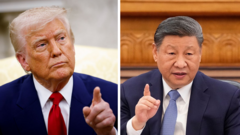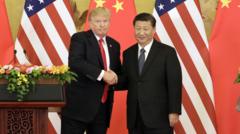The US and China have announced significant reductions in import tariffs following an agreement to ease trade tensions. This truce may pave the way for improved economic relations, though uncertainties remain regarding future negotiations.
US-China Tariff Agreement: A New Chapter in Trade Relations

US-China Tariff Agreement: A New Chapter in Trade Relations
The recent truce between the United States and China aims to reduce import tariffs, signaling a potential shift in their long-standing trade tensions.
The United States and China have reached a landmark agreement to lower tariffs on goods exchanged between the two nations, marking a significant de-escalation in their ongoing trade conflict. This development comes as a relief not only to the involved nations but also to several economies worldwide impacted by the trade war.
What are the key details of this agreement? Both governments have confirmed plans to roll back certain tariffs imposed in response to previous escalations initiated by the Trump administration. The deal entails mutual tariff reductions, with US tariffs on Chinese imports decreasing from 145% to 30%, while China lowers tariffs on various US imports from 125% to 10%. Additionally, China has halted non-tariff measures that affected critical mineral exports to the US, previously implemented as a reaction to heightened tensions.
The recent discussions held in Switzerland were the first between the two superpowers since the trade war deepened earlier in the year, and the announcement has generated optimism across global markets. Despite the lifted tariffs, certain pressures remain, including a 20% additional component aimed at prompting China to take stricter action against the illegal fentanyl trade.
Looking ahead to the next 90 days, there are mixed predictions regarding the future of this fragile truce. While the reduction of tariffs is a notable accomplishment, the reinstatement of suspended tariffs could still occur if further agreements are not reached. By then, US tariffs on Chinese goods would only rise to 54%, while Chinese tariffs would increase to 34%. Continuous dialogue is anticipated, as both governments express a desire to avoid complete economic decoupling.
When it comes to trade goods, the United States exports significant quantities of soybeans, pharmaceuticals, and petroleum to China, which in turn exports electronics, computers, and toys back to the US. The trade balance, however, heavily favors China, with US imports totaling $440 billion against exports of $145 billion, an imbalance that has historically caused concern for American policymakers.
As both nations claim victories in this agreement, the interpretation of the truce may differ. US officials portray the outcome as a benefit for American consumers, while analysts note that China might perceive it as a gain in their negotiating power. Although both countries acknowledge the deal's potential, it's clear that future negotiations will be vital in determining its long-term impacts on global trade relations.
In the end, this tariff agreement represents a cautious step toward bridging the divide between the US and China, with significant implications for the global economy and future trade dynamics.























